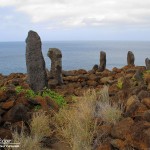The Hawaiian islands are quite interesting in many respects. Here no single ethnicity has an outright majority. The history behind this makes for fascinating reading. The sugar industry created a need for agricultural labor that was the driving force resulting in the mass importation of several cultures, primarily Chinese, Japanese and Filipino, and to a lesser extent several others. In addition to the original Hawaiian inhabitants and later Americans immigrants the islands became quite culturally mixed.

While there are many benefits of several coexisting cultures, there are issues as well. Hawaiʻi is in many ways ahead of much of the world. These cultures have, for the most part, learned to coexist in ways that much of the world is still struggling with. This is not to say that everything is perfect. Controversy has a way of revealing issues that otherwise often avoid exposure, and we have seen a bit of controversy as of late. There are existing issues that have long been present, but are avoided as they are neither simple nor easily resolved. It is no surprise that the issues have stemmed from the clash of cultures that have landed on these islands across the centuries.
It is the first arrivals here, the Hawaiians, that often see themselves as having lost the most with the arrival of so many immigrants from various other nations. The issues surrounding Mauna Kea have given Hawaiian activists a new rallying point and increased visibility that they have taken full advantage of to express their cause.
Even defining who is and who is not Hawaiian is a hotly contentious issue. Centuries of intermarriage have created families of mixed heritage. For many, the definition of Hawaiian is in the culture and the language. To live the culture, to speak the language, to identify with the ideals of Hawaiian culture becomes possibly the only workable definition of Hawaiian. These things become jealousy protected, even the use of Hawaiian words or icons by anyone seen as non-Hawaiian can create an issue.
The use of cultural symbols by those who are not part of that culture is often defined as cultural appropriation. For those who object to such usage it might be referred to as cultural misappropriation. The right and wrong of these exchanges is a hotly debated topic in some circles.
The issue of cultural appropriation is most apparent where the issues of culture are a major facet of island controversies. To some even the use of Hawaiian words by a non-Hawaiian is seen as offensive or condescending. Often those arguing from a cultural standpoint make a practice of using Hawaiian words in their writings to make a point. The use of Hawaiian language and Hawaiian symbols either becomes a tactic or a point of controversy.

What is appropriate? When is is acceptable to use elements or symbols of a culture? Can members of another culture use those symbols? Many argue that this is never acceptable, they seek control over their culture’s “intellectual property” and would deny anyone outside their culture use of those ideas.
The problem is not unique to Hawaii, it arises anyplace where traditional cultures contact the dominant cultures of this modern and very connected world. It exemplifies the very contentious issues that arise from that interface. How do we preserve ancient heritage while allowing for the overlay of a modern culture?
Indigenous peoples have the right to maintain, control, protect and develop their cultural heritage, traditional knowledge and traditional cultural expressions, as well as the manifestations of their sciences, technologies and cultures, including human and genetic resources, seeds, medicines, knowledge of the properties of fauna and flora, oral traditions, literatures, designs, sports and traditional games and visual and performing arts. They also have the right to maintain, control, protect and develop their intellectual property over such cultural heritage, traditional knowledge, and traditional cultural expressions. — Declaration on the Rights of Indigenous Peoples, Article 31 1
Much of the UN Declaration of Rights of Indigenous Peoples is a noble document, it seeks to address many of the wrongs perpetrated throughout history and the repercussions that are still with us today. But the document also has a great number of problematical assertions, I find I must agree with the United States opposition to the adoption of this declaration. This statement is a very good example of why. While much of this statement is positive there is one very troubling word… “Control” I have no issue with a people or culture actively seeking to preserve and develop their heritage, indeed I would support such efforts. It is when a culture attempts to assert an ownership of knowledge or ideas that I find I must strenuously object.

Of course there are various sorts of knowledge here. The UN declaration makes reference to very practical things, to seeds, medicines and genetic heritage. There are also the less practical things that are even more tied to a cultural heritage, to artwork and iconography, or simply the style of art, of legends and traditions, the very things that define a culture. Often it is difficult to separate these things, that it is all integral to the culture in question.

Is it possible to own or control knowledge? In one limited way, yes, under the patent system which provides for exclusive use of an idea. I will not deny that the patent system has been routinely and badly abused for commercial gain, after all commercial gain was why the patent system was established. However, the system still performs its basic function… That knowledge may be owned and exploited, for a limited time, in exchange for disclosure of that knowledge to the commons. Patents expire in a relatively short time, a mere 20 years, after which time that knowledge is added to the commons, free for use by all. Indigenous knowledge is not subject to patent, the ideas are not “original” or “novel”, requirements of patent law. Others might indicate copyright as another form of legal protection, but copyright only protects a specific version of the idea, not the idea itself. Others are free to create derivations of the works protected by copyright.

Is it always permissible to use the particular icons of another culture? No. There are plentiful examples of using the symbols of cultural identity in a way that negatively reflects upon the culture from which the symbol originates. I would also assert that this is a moral consideration, not a legal consideration. I would go further in asserting that negative portrayals of a culture’s iconography or beliefs, while potentially morally objectionable to some should never be subject to legal protections. The moral consideration is extraordinarily subject to the senses of the beholder. What is acceptable to one may be objectionable to another and we should be very careful in defining what is and is not acceptable, often refraining from even attempting to do so.
Consider the ongoing controversy over the use of Native American symbols by various sporting franchises. Teams like the Cleveland Indians, Atlanta Braves, or the Washington Redskins use logos that portray images that many find issue with. The question is very subject to personal beliefs. On one side is the perception by some that the use of such symbols is cultural misappropriation, portraying a culture in negative light. On the other side is that the use of such symbols celebrates a culture. The answer is not simple or clear cut here and should be open to free discussion. Personally I find the Redskins to be a racially problematic team name which should be changed, while I have no problem with the Atlanta Braves or the more local use by the University of Hawaii of Warriors as a team name. I do not expect you to agree with me.
While it is simple to demonstrate why any legal protection of cultural symbols is objectionable. It also allows us to see why we must allow most such uses on moral grounds. It has been routinely seen that uses intended to be positive are often negatively interpreted by others. This parallels why any form of blasphemy laws or protections for a religion are morally wrong, that the intent of one can not be interpreted by others.
Indeed, many cultures and religions have elements that are very subject to criticism and while that criticism may be labeled as offensive by some, it should be protected speech. A few examples of objectionable cultural practices? Child marriage, honor killings, the subordinate role of women in many cultures, the list is long. So often the first defense of a controversial practice by adherents is to claim that this is a cultural or religious issue and must not be questioned, that criticism is blasphemy or that their freedom of religion is threatened, or that your are insulting a cultural practice. Every culture has issues large and small that should be open for discussion. Negative criticisms of a culture or religion, often take the form of using that culture’s iconography in a negative way.
Use of cultural iconography in a commercial manner is also contentious. Consider one of the most common examples of what is cited as cultural misappropriation, use of cultural iconography in art by an artist who is not a member of that culture. Any visit to a Hawaiian craft fair or tourist gift shop will provide examples of this, artists are often inspired by the local culture. Hawaiian iconography is a staple of many artists in Hawaiʻi, regardless of the cultural background of the artist. It is also very commercial, art incorporating island culture is quite popular with visitors, artists need to sell to make a living.
It is easy to understand the motivations here, why the accusation of cultural misappropriation is made. Culture is highly personal to many, particularly those who see their local culture being lost to the allure of the more dominant cultures of our world. It is not unusual to encounter someone who has become so embittered that the accusations are made of anyone outside their culture regardless of the intent. While I understand such objections I can not agree.
Key to the definition of cultural appropriation is the relationship between the cultures in question. Much of the argument depends of one culture being dominant while the other is under pressure from that dominant culture. The problem is that this relationship is going to happen. Even if our society manages to move past the issues of systemic racism and discrimination, which to my somewhat optimistic view appears increasingly possible, there will still be a dominant culture relationship. Gone is the era where geographic isolation could preserve a culture from the effects of cultural clash. Our ever more connected modern world has reached nearly every isolated pocket of the globe. Members of once isolated societies are now exposed to foreign ideas and languages like never before. In particular members of younger generations who are still defining themselves and are most likely to adopt outside ideas.
Making room for traditional cultures to exist or even thrive within the more dominant global cultures is a challenge, one I am not sure will succeed in the long term. It is inevitable that much will be lost, we can only strive to preserve what we can and give our support for those who choose to live in traditional ways. It is also important to recognize the old ideas that have value while being free to criticize those that may be troubling. Borrowing of traditional symbols and iconography does not detract from the traditional culture, it preserves it. I know that many Hawaiian words and values will remain with me even if I eventually leave the islands. We just need to remember where those images and ideas came from, to recognize the debt we owe to those who came before and to celebrate their achievements.

